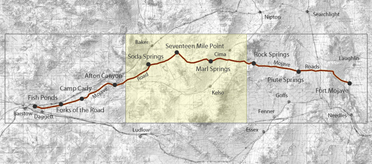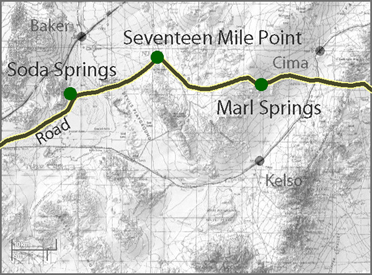Marl Springs

This was an interesting historical spot along the Mojave Road. It wasn't until the Army Surveyor Lt. Amiel Whipple christened Marl Springs, back in 1854, that this spring gained importance for travelers. Marl was a name given to springs because of the marl, or clay-like soil, around the waterholes, and marked a much-needed stop along the Mojave Road after the establishment of Fort Mojave in 1859.
Because of its location-more than 30 miles east of Soda Springs-today's Zzyzx, Marl Springs provided a reliable, though limited, water source. It was established as a military outpost in 1867 where a contingent of soldiers from Company K of the 14th U.S. Infantry was stationed to escort supply trains and guard the mail. The garrison was even attacked in October of 1867 but it held out until reinforcements could arrive.
Over the years, Marl Springs has also witnessed sporadic mining and milling operations and today remains a vital resource for local wildlife. It stands as a testament to the challenges and resilience required to survive in the harsh Mojave Desert.
Marl Springs has a rich history situated along the historic Mojave Road and contributes directly to the history of travel and settlement in the Mojave Desert. It was named in 1854 by Army Surveyor Lt. Amiel Whipple, who observed the clay-like marl soil surrounding the two waterholes at the site. Marl Springs thus developed as one of the very few reliable sources of water out there in the desert and became an important stopover, especially with the founding of Fort Mojave in 1859. All this was solidified into permanence with the formation of the Mojave Road, otherwise known as the Old Government Road, and provided a critical link between the Pacific coast and interior parts of the U.S.
By the mid-1860s, Marl Springs was a heavily used stopover by military detachments assigned to patrol the Mojave Road, convey supply trains, and guard mail routes. During the fall of 1867, soldiers from Company K, 14th U.S. Infantry, garrisoned the springs. On October 17, that year, the post at Marl Springs was assaulted by 20 to 30 Indians. The three-man garrison held at bay the attackers all night, and the siege was relieved when 150 soldiers were sent in a column next morning. This incident showed the strategic importance of Marl Springs in days when control of desert routes was highly contested.
With the military abandoning the outpost in May 1868 at Marl Springs, the site was still to see periodic use throughout the years to follow-the Mojave Road serving settlers, miners, and other travelers across the desert. Other sporadic mining and milling operations also occurred at Marl Springs, but none became major industries. Indeed, the springs have continued to be life-giving sources of water for local wildlife, once again demonstrating their age-old importance in this unforgiving desert environment.
Visitors come to this place today to see remains of the military camp, who have an interest in the rude past of the Mojave Desert.
Marl Springs was named in 1854 by Army Surveyor Lt. Amiel Whipple for the clay-like soil around the two waterholes. With the establishment of Fort Mojave in 1859, the Mojave (or Old Government) Road came into existence. Marl Springs became an important stop over being more than 30 miles eastward from the last dependable water Soda Springs (now Zzyzx). Though never abundant, the water here has always been reliable.

In the fall of 1867 the springs were garrisoned by soldiers of Company K, 14th U.S. Infantry, who escorted supply trains and guarded the mail. On October 17, 1867, the post, manned by three soldiers, was attacked by a group of 20 to 30 Indians. The defenders held out through the night and the siege was lifted the next morning when a column of 150 soldiers appeared on the horizon. The outpost was abandoned in May, 1868.
Marl Springs has been witness to sporadic mining and milling operations over the years and continues to serve local wildlife.
ECV - Billy Holcomb


Marl Springs in 1863
Military at Marl Springs
Marl Springs Gallery
On the Frontier
Marl Springs, located within the Mojave National Preserve, is a notable historical and natural site with several points of interest:Historical Significance
Marl Springs was an essential water stop for travelers along the historic Mojave Road, a vital transportation route for Native Americans, explorers, and settlers.Military History:
The springs served as a critical water source for the U.S. Army during the late 19th century, particularly for the protection of the travelers from Native American raids.Natural Features
Spring:
The actual spring is a natural water source in the desert, making it a crucial spot for wildlife and a rare sight in the arid landscape.Flora and Fauna:
The area around Marl Springs is home to a variety of desert plants and animals, including creosote bushes, Joshua trees, and desert tortoises.Recreational Activities
Hiking:
There are trails that provide scenic views and opportunities to explore the desert environment.Wildlife Viewing:
Visitors can spot various desert species that rely on the spring for survival.Historical Exploration:
The site offers a glimpse into the past with remnants of old military outposts and markers along the Mojave Road.Accessibility
Remote Location:
Marl Springs is relatively remote and may require a high-clearance vehicle to access, particularly after weather events that can affect the dirt roads.Preservation:
As part of the Mojave National Preserve, the area is protected and managed by the National Park Service, ensuring its preservation for future generations.Marl Springs provides a unique blend of history and natural beauty, making it a fascinating destination for those interested in the Mojave Desert's past and present.